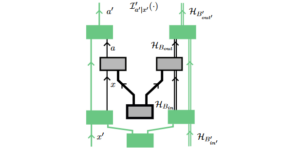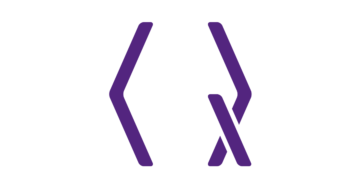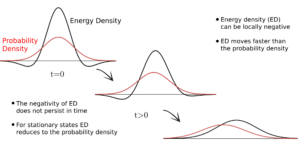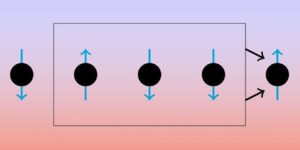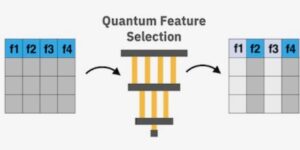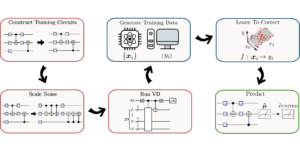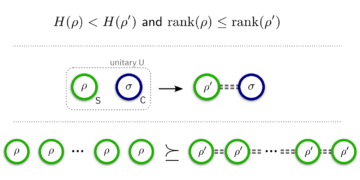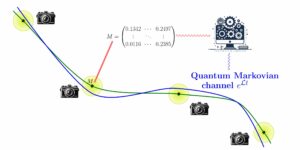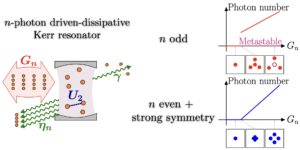1Physics Department, University of Massachusetts Boston, 02125, VS.
2Dipartimento di Fisica `Ettore Pancini', Università degli Studi di Napoli Federico II, Via Cintia 80126, Napoli, Italy
3INFN, Sezione di Napoli, Italië
Vind je dit artikel interessant of wil je het bespreken? Scite of laat een reactie achter op SciRate.
Abstract
Verstrengeling is het bepalende kenmerk van de kwantummechanica. Bipartiete verstrengeling wordt gekenmerkt door de von Neumann-entropie. Verstrengeling wordt echter niet alleen beschreven door een cijfer; het wordt ook gekenmerkt door zijn complexiteitsniveau. De complexiteit van verstrengeling ligt aan de basis van het ontstaan van kwantumchaos, universele distributie van verstrengelingsspectrumstatistieken, hardheid van een ontwarrend algoritme en van het leren door kwantummachine van een onbekend willekeurig circuit, en universele temporele verstrengelingsfluctuaties. In dit artikel laten we numeriek zien hoe een overgang van een eenvoudig verstrengelingspatroon naar een universeel, complex patroon kan worden aangestuurd door een willekeurig Clifford-circuit met $T$-poorten te doteren. Dit werk laat zien dat kwantumcomplexiteit en complexe verstrengeling voortkomen uit de combinatie van verstrengeling en niet-stabiliserende bronnen, ook wel magie genoemd.
Uitgelichte afbeelding: weergave van een kleurenkaart van een staat van 16 qubits na $ 10N^2$ willekeurige Clifford-poorten, vervolgens $n_T$ willekeurige $T$-poorten $($Bovenste rij: $n_T{=}5$. Onderste rij: $n_T {=}20)$, dan worden nog eens $10N^2$ willekeurige Clifford-poorten toegepast, te beginnen met de begintoestand $left|psi_0right>{=}left|0right>^{otimes N}$. Het beeld wordt gerangschikt door de toestand in twee gelijke subsystemen te verdelen en één langs elke as uit te breiden. Een pixel op een bepaalde positie $(x, y)$ wordt afgebeeld op basis van de grootte van de amplitude voor de computationele basistoestand $left|sigma_{xy}right>{=}left|sigma_xright>{otimes}left|sigma_yright>$ $ ($ de pixel op $(0, 0)$ komt bijvoorbeeld overeen met de toestand $left|sigma_{00}right>{=}left|0right>^{otimes N/2}{otimes}left|0right>^ {soms N/2})$. De actie van een $T$-poort, die een fasepoort is, verandert de weergave van de kleurenkaart helemaal niet. Na te zijn verspreid door het tweede Clifford-circuit, wordt de weergave van de kleurenkaart echter meer gemengd voor het circuit met het grotere aantal ingevoegde $ T $ -poorten, wat het samenspel laat zien tussen de niet-Clifford-bronnen en de operator die zich verspreidt door Clifford-gestuurde verstrikking in het begin van kwantumchaos.
► BibTeX-gegevens
► Referenties
[1] JP Eckmann en D. Ruelle, Ergodische theorie van chaos en vreemde aantrekkers, Rev. Mod. Fys. 57, 617 (1985), 10.1103/RevModPhys.57.617.
https: / / doi.org/ 10.1103 / RevModPhys.57.617
[2] D. Rickles, P. Hawe en A. Shiell, Een eenvoudige gids voor chaos en complexiteit, Journal of Epidemiology & Community Health 61(11), 933 (2007), 10.1136/jech.2006.054254.
https:///doi.org/10.1136/jech.2006.054254
[3] G. Boeing, Visuele analyse van niet-lineaire dynamische systemen: chaos, fractals, zelfgelijkenis en de limieten van voorspelling, Systems 4 (4) (2016), 10.3390/systems4040037.
https:///doi.org/10.3390/systems4040037
[4] SH Strogatz, niet-lineaire dynamiek en chaos: met toepassingen voor natuurkunde, biologie, scheikunde en techniek, Westview Press, 10.1201/9780429492563 (2015).
https: / / doi.org/ 10.1201 / 9780429492563
[5] F. Haake, S. Gnutzmann en M. Kuś, Quantum Signatures of Chaos, Springer International Publishing, 10.1007/978-3-319-97580-1 (2018).
https://doi.org/10.1007/978-3-319-97580-1
[6] JS Cotler, D. Ding en GR Penington, Out-of-time-order operators en het vlindereffect, Annals of Physics 396, 318 (2018), 10.1016/j.aop.2018.07.020.
https: / / doi.org/ 10.1016 / j.aop.2018.07.020
[7] A. Bhattacharyya, W. Chemissany et al., Towards the web of quantum chaos diagnostics, The European Physical Journal C 82(1) (2022), 10.1140/epjc/s10052-022-10035-3.
https://doi.org/10.1140/epjc/s10052-022-10035-3
[8] S. Chaudhury, A. Smith et al., Quantum signatures of chaos in a kicked top, Nature 461 (7265), 768 (2009), 10.1038/nature08396.
https: / / doi.org/ 10.1038 / nature08396
[9] DA Roberts en B. Yoshida, Chaos en complexiteit door ontwerp, Journal of High Energy Physics 2017(4) (2017), 10.1007/jhep04(2017)121.
https:///doi.org/10.1007/jhep04(2017)121
[10] DA Roberts en B. Swingle, Lieb-robinson gebonden en het vlindereffect in kwantumveldentheorieën, Phys. ds. Lett. 117, 091602 (2016), 10.1103/PhysRevLett.117.091602.
https: / / doi.org/ 10.1103 / PhysRevLett.117.091602
[11] YY Atas, E. Bogomolny et al., Verdeling van de verhouding van opeenvolgende niveauafstanden in willekeurige matrix-ensembles, Phys. ds. Lett. 110, 084101 (2013), 10.1103/PhysRevLett.110.084101.
https: / / doi.org/ 10.1103 / PhysRevLett.110.084101
[12] J. Cotler, N. Hunter-Jones et al., Chaos, complexiteit en willekeurige matrices, Journal of High Energy Physics (Online) 2017(11) (2017), 10.1007/jhep11(2017)048.
https:///doi.org/10.1007/jhep11(2017)048
[13] JS Cotler, G. Gur-Ari et al., Zwarte gaten en willekeurige matrices, Journal of High Energy Physics 2017(5), 118 (2017), 10.1007/JHEP05(2017)118.
https: / / doi.org/ 10.1007 / JHEP05 (2017) 118
[14] H. Gharibyan, M. Hanada et al., Begin van willekeurig matrixgedrag in scrambling-systemen, Journal of High Energy Physics 2018(7), 124 (2018), 10.1007/JHEP07(2018)124.
https: / / doi.org/ 10.1007 / JHEP07 (2018) 124
[15] SFE Oliviero, L. Leone et al., Random Matrix Theory of the Isospectral twirling, SciPost Phys. 10, 76 (2021), 10.21468 / SciPostPhys.10.3.076.
https: / / doi.org/ 10.21468 / SciPostPhys.10.3.076
[16] L. Leone, SFE Oliviero en A. Hamma, Isospectral twirling en kwantumchaos, Entropy 23(8) (2021), 10.3390/e23081073.
https: / / doi.org/ 10.3390 / e23081073
[17] W.-J. Rao, Higher-order level spacings in random matrix theory based on wigner's conjecture, Phys. Rev. B 102, 054202 (2020), 10.1103/PhysRevB.102.054202.
https: / / doi.org/ 10.1103 / PhysRevB.102.054202
[18] X. Wang, S. Ghose et al., Verstrengeling als een kenmerk van kwantumchaos, Phys. Rev. E 70, 016217 (2004), 10.1103/PhysRevE.70.016217.
https: / / doi.org/ 10.1103 / PhysRevE.70.016217
[19] X. Chen en AWW Ludwig, Universele spectrale correlaties in de chaotische golffunctie en de ontwikkeling van kwantumchaos, Phys. Rev. B 98, 064309 (2018), 10.1103/PhysRevB.98.064309.
https: / / doi.org/ 10.1103 / PhysRevB.98.064309
[20] P. Hosur, X.-L. Qi et al., Chaos in kwantumkanalen, Journal of High Energy Physics 2016, 4 (2016), 10.1007/JHEP02(2016)004.
https: / / doi.org/ 10.1007 / JHEP02 (2016) 004
[21] Z.-W. Liu, S. Lloyd et al., Verstrengeling, kwantumwillekeurigheid en complexiteit voorbij scrambling, Journal of High Energy Physics 2018(7) (2018), 10.1007/jhep07(2018)041.
https:///doi.org/10.1007/jhep07(2018)041
[22] M. Kumari en S. Ghose, Ontwarring en chaos, Phys. Rev. A 99, 042311 (2019), 10.1103/PhysRevA.99.042311.
https: / / doi.org/ 10.1103 / PhysRevA.99.042311
[23] A. Hamma, S. Santra en P. Zanardi, Kwantumverstrengeling in willekeurige fysieke toestanden, Phys. ds. Lett. 109, 040502 (2012), 10.1103/PhysRevLett.109.040502.
https: / / doi.org/ 10.1103 / PhysRevLett.109.040502
[24] A. Hamma, S. Santra en P. Zanardi, Ensembles van fysieke toestanden en willekeurige kwantumcircuits op grafieken, Phys. Rev. A 86, 052324 (2012), 10.1103/PhysRevA.86.052324.
https: / / doi.org/ 10.1103 / PhysRevA.86.052324
[25] R. Jozsa, Verstrengeling en kwantumberekening, 10.48550/ARXIV.QUANT-PH/9707034 (1997).
https:///doi.org/10.48550/ARXIV.QUANT-PH/9707034
[26] J. Preskill, Quantum computing en de verstrengelingsgrens, 10.48550/ARXIV.1203.5813 (2012).
https:///doi.org/10.48550/ARXIV.1203.5813
[27] Y. Sekino en L. Susskind, Fast scramblers, Journal of High Energy Physics 2008(10), 065 (2008), 10.10881126-6708/2008/10/065.
https://doi.org/10.1088/1126-6708/2008/10/065
[28] P. Hayden en J. Preskill, Zwarte gaten als spiegels: kwantuminformatie in willekeurige subsystemen, Journal of High Energy Physics 2007(09), 120 (2007), 10.10881126-6708/2007/09/120.
https://doi.org/10.1088/1126-6708/2007/09/120
[29] KA Landsman, C. Figgatt et al., Verified quantum information scrambling, Nature 567(7746), 61-65 (2019), 10.1038/s41586-019-0952-6.
https://doi.org/10.1038/s41586-019-0952-6
[30] B. Yoshida en A. Kitaev, Efficiënte decodering voor het hayden-preskill-protocol, 10.48550/ARXIV.1710.03363 (2017).
https:///doi.org/10.48550/ARXIV.1710.03363
[31] D. Ding, P. Hayden en M. Walter, Conditional mutual information of bipartite unitaries and scrambling, Journal of High Energy Physics 2016 (12), 145 (2016), 10.1007 / JHEP12 (2016) 145.
https: / / doi.org/ 10.1007 / JHEP12 (2016) 145
[32] B. Swingle, G. Bentsen et al., Het door elkaar gooien van kwantuminformatie meten, Physical Review A 94, 040302 (2016), 10.1103/PhysRevA.94.040302.
https: / / doi.org/ 10.1103 / PhysRevA.94.040302
[33] D. Gottesman, De Heisenberg-representatie van kwantumcomputers (1998), 10.48550/ARXIV.QUANT-PH/9807006.
https:///doi.org/10.48550/ARXIV.QUANT-PH/9807006
[34] MA Nielsen en IL Chuang, Quantum-informatietheorie, p. 528–607, Cambridge University Press, 10.1017/CBO9780511976667.016 (2010).
https: / / doi.org/ 10.1017 / CBO9780511976667.016
[35] AW Harrow en A. Montanaro, Quantum computationele suprematie, Nature 549(7671), 203–209 (2017), 10.1038/nature23458.
https: / / doi.org/ 10.1038 / nature23458
[36] RP Feynman, Simulating physics with computers, International Journal of Theoretical Physics 21(6), 467 (1982), 10.1007/BF02650179.
https: / / doi.org/ 10.1007 / BF02650179
[37] L. Leone, SFE Oliviero et al., Quantum Chaos is Quantum, Quantum 5, 453 (2021), 10.22331/q-2021-05-04-453.
https://doi.org/10.22331/q-2021-05-04-453
[38] SF Oliviero, L. Leone en A. Hamma, Overgangen in verstrengelingscomplexiteit in willekeurige kwantumcircuits door metingen, Physics Letters A 418, 127721 (2021), 10.1016/j.physleta.2021.127721.
https: / / doi.org/ 10.1016 / j.physleta.2021.127721
[39] S. Bravyi en D. Gosset, Verbeterde klassieke simulatie van kwantumcircuits gedomineerd door Clifford-poorten, Physical Review Letters 116, 250501 (2016), 10.1103 / PhysRevLett.116.250501.
https: / / doi.org/ 10.1103 / PhysRevLett.116.250501
[40] J. Haferkamp, F. Montealegre-Mora et al., Quantum homeopathie werkt: efficiënte unitaire ontwerpen met een systeemgrootte onafhankelijk aantal niet-clifford poorten, 10.48550/ARXIV.2002.09524 (2020).
https:///doi.org/10.48550/ARXIV.2002.09524
[41] P. Boykin, T. Mor et al., Een nieuwe universele en fouttolerante kwantumbasis, Information Processing Letters 75(3), 101 (2000), 10.1016/S0020-0190(00)00084-3.
https://doi.org/10.1016/S0020-0190(00)00084-3
[42] D. Gottesman, Een inleiding tot kwantumfoutcorrectie en fouttolerante kwantumberekening, 10.48550/ARXIV.0904.2557 (2009).
https:///doi.org/10.48550/ARXIV.0904.2557
[43] NJ Ross en P. Selinger, Optimale ancilla-vrije clifford+t-benadering van z-rotaties, Quantum Info. Berekenen. 16(11–12), 901–953 (2016), 10.26421/QIC16.11-12-1.
https: / / doi.org/ 10.26421 / QIC16.11-12-1
[44] D. Litinski, Een spel met oppervlaktecodes: grootschalige kwantumcomputing met roosterchirurgie, Quantum 3, 128 (2019), 10.22331/q-2019-03-05-128.
https://doi.org/10.22331/q-2019-03-05-128
[45] T. Bækkegaard, LB Kristensen et al., Realisatie van efficiënte kwantumpoorten met een supergeleidend qubit-qutrit-circuit, Scientific Reports 9(1) (2019), 10.1038/s41598-019-49657-1.
https://doi.org/10.1038/s41598-019-49657-1
[46] Q. Wang, M. Li et al., Voor hulpbronnen geoptimaliseerde fermionische lokaal-hamiltoniaanse simulatie op een kwantumcomputer voor kwantumchemie, Quantum 5, 509 (2021), 10.22331/q-2021-07-26-509.
https://doi.org/10.22331/q-2021-07-26-509
[47] V. Gheorghiu, M. Mosca en P. Mukhopadhyay, T-telling en t-diepte van elke multi-qubit unitair, 10.48550/ARXIV.2110.10292 (2021).
https:///doi.org/10.48550/ARXIV.2110.10292
[48] C. Chamon, A. Hamma en ER Mucciolo, Emergent onomkeerbaarheid en verstrengeling spectrum statistieken, Physical Review Letters 112, 240501 (2014), 10.1103 / PhysRevLett.112.240501.
https: / / doi.org/ 10.1103 / PhysRevLett.112.240501
[49] D. Shaffer, C. Chamon et al., Onomkeerbaarheids- en verstrengelingsspectrumstatistieken in kwantumcircuits, Journal of Statistical Mechanics: Theory and Experiment 2014 (12), P12007 (2014), 10.1088/1742-5468/2014/12 /p12007.
https://doi.org/10.1088/1742-5468/2014/12/p12007
[50] S. Zhou, Z. Yang et al., Enkele T-poort in een Clifford-circuit stimuleert de overgang naar universele verstrengelingsspectrumstatistieken, SciPost Phys. 9, 87 (2020), 10.21468 / SciPostPhys.9.6.087.
https: / / doi.org/ 10.21468 / SciPostPhys.9.6.087
[51] Z. Yang, A. Hamma et al., Verstrengelingscomplexiteit in quantum veellichamendynamica, thermalisatie en lokalisatie, Physical Review B 96, 020408 (2017), 10.1103/PhysRevB.96.020408.
https: / / doi.org/ 10.1103 / PhysRevB.96.020408
[52] A. Nahum, J. Ruhman et al., Kwantumverstrengelinggroei onder willekeurige unitaire dynamiek, Physical Review X 7 (3) (2017), 10.1103/physrevx.7.031016.
https: / / doi.org/ 10.1103 / physrevx.7.031016
[53] A. Nahum, S. Vijay en J. Haah, Operator die zich verspreidt in willekeurige unitaire circuits, Physical Review X 8, 021014 (2018), 10.1103 / PhysRevX.8.021014.
https: / / doi.org/ 10.1103 / PhysRevX.8.021014
[54] X. Mi, P. Roushan et al., Informatie versleuteling in kwantumcircuits, Science 374 (6574), 1479-1483 (2021), 10.1126/science.abg5029.
https://doi.org/10.1126/science.abg5029
[55] DA Roberts, D. Stanford en L. Susskind, Gelokaliseerde schokken, Journal of High Energy Physics 2015(3), 51 (2015), 10.1007/JHEP03(2015)051.
https: / / doi.org/ 10.1007 / JHEP03 (2015) 051
[56] S. Moudgalya, T. Devakul et al., Operator verspreiding in kwantumkaarten, Physical Review B 99 (9) (2019), 10.1103/physrevb.99.094312.
https: / / doi.org/ 10.1103 / physrevb.99.094312
[57] L. Amico, F. Baroni et al., Divergentie van het verstrengelingsbereik in laagdimensionale kwantumsystemen, Phys. Rev. A 74, 022322 (2006), 10.1103/PhysRevA.74.022322.
https: / / doi.org/ 10.1103 / PhysRevA.74.022322
[58] N. Linden, S. Popescu et al., Kwantummechanische evolutie naar thermisch evenwicht, Physical Review E 79, 061103 (2009), 10.1103/PhysRevE.79.061103.
https: / / doi.org/ 10.1103 / PhysRevE.79.061103
[59] JR McClean, S. Boixo et al., Barren plateaus in quantum neurale netwerktrainingslandschappen, Nature Communications 9(1), 4812 (2018), 10.1038/s41467-018-07090-4.
https://doi.org/10.1038/s41467-018-07090-4
[60] Z. Holmes, A. Arrasmith et al., Barren plateaus sluiten lerende scramblers uit, Phys. ds. Lett. 126, 190501 (2021), 10.1103/PhysRevLett.126.190501.
https: / / doi.org/ 10.1103 / PhysRevLett.126.190501
[61] M. Cerezo, A. Sone et al., Kostenfunctie-afhankelijke kale plateaus in ondiepe geparametriseerde kwantumcircuits, Nature Communications 12(1), 1791 (2021), 10.1038/s41467-021-21728-w.
https: / / doi.org/ 10.1038 / s41467-021-21728-w
[62] RJ Garcia, C. Zhao et al., Barren plateaus from learning scramblers met lokale kostenfuncties, 10.48550/ARXIV.2205.06679 (2022).
https:///doi.org/10.48550/ARXIV.2205.06679
[63] L. Leone, SFE Oliviero en A. Hamma, stabilisator Rényi Entropy, Phys. ds. Lett. 128(5), 050402 (2022), 10.1103/PhysRevLett.128.050402.
https: / / doi.org/ 10.1103 / PhysRevLett.128.050402
[64] ET Campbell, Katalyse en activering van magische toestanden in fouttolerante architecturen, Physical Review A 83 (3) (2011), 10.1103/physreva.83.032317.
https: / / doi.org/ 10.1103 / physreva.83.032317
[65] K. Goto, T. Nosaka en M. Nozaki, Chaos door magie, 10.48550/ARXIV.2112.14593 (2021).
https:///doi.org/10.48550/ARXIV.2112.14593
[66] AW Harrow, L. Kong et al., Scheiding van buiten de tijd geordende correlatie en verstrengeling, PRX Quantum 2, 020339 (2021), 10.1103/PRXQuantum.2.020339.
https: / / doi.org/ 10.1103 / PRXQuantum.2.020339
[67] L. Leone, SFE Oliviero et al., To learn a mocking-black hole, 10.48550/ARXIV.2206.06385 (2022).
https:///doi.org/10.48550/ARXIV.2206.06385
Geciteerd door
[1] Lorenzo Leone, Salvatore F. E. Oliviero, and Alioscia Hamma, "Magic hinders quantum certification", arXiv: 2204.02995.
[2] Tobias Haug and M. S. Kim, "Scalable measures of magic for quantum computers", arXiv: 2204.10061.
[3] Lorenzo Leone, Salvatore F. E. Oliviero, Stefano Piemontese, Sarah True, and Alioscia Hamma, "To Learn a Mocking-Black Hole", arXiv: 2206.06385.
Bovenstaande citaten zijn afkomstig van SAO / NASA ADS (laatst bijgewerkt met succes 2022-09-22 16:45:47). De lijst is mogelijk onvolledig omdat niet alle uitgevers geschikte en volledige citatiegegevens verstrekken.
Kon niet ophalen Door Crossref geciteerde gegevens tijdens laatste poging 2022-09-22 16:45:45: kon niet geciteerde gegevens voor 10.22331 / q-2022-09-22-818 niet ophalen van Crossref. Dit is normaal als de DOI recent is geregistreerd.
Dit artikel is gepubliceerd in Quantum onder de Creative Commons Naamsvermelding 4.0 Internationaal (CC BY 4.0) licentie. Het auteursrecht blijft berusten bij de oorspronkelijke houders van auteursrechten, zoals de auteurs of hun instellingen.


